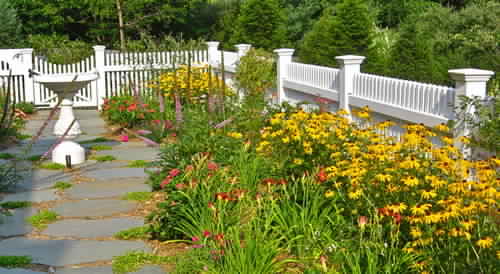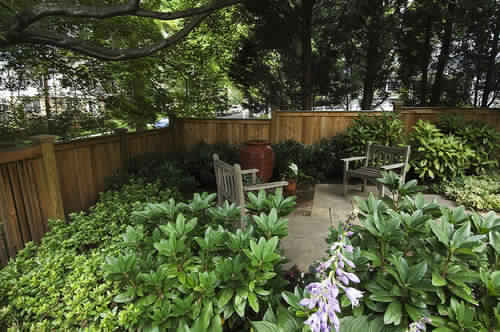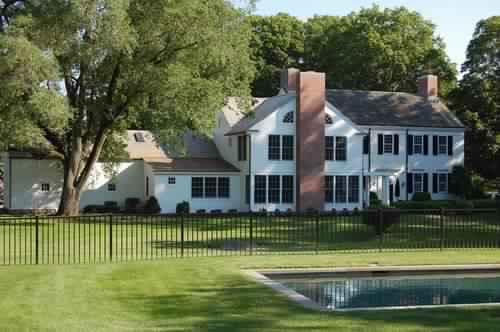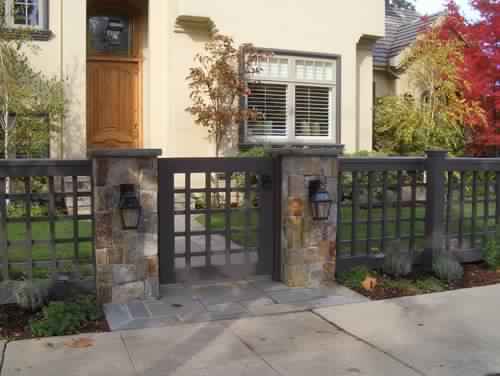 photo by Liquidscapes
photo by Liquidscapes
Fences make good neighbors, the saying goes. Fences work great for privacy, it helps keep wildlife out of the yard, and even provides aesthetically pleasing backdrops in the landscape. If you are adding a fence along your property line, make sure you know where the property line is. The safest way I have found is to pay to have a survey completed. Ask the surveyor to put down stakes every 8 - 16 feet where the property line is and where you would like the fence added. This will cost around $450 to $750 depending on the size of the lot. You can ask the local engineering firm in your area to give you an estimate and most will do this over the phone. It is okay to call around to get the best deal on a survey. When you decide to build the fence, set the fence back onto your property and not right on the line. When I built my fence, I set the fence back on my side 12”. Make sure you call 811 and get your utility lines marked before any digging. Also, be sure to check with your local zoning on if you need a permit and the requirements for a fence in your area.
There are several different choices to choose from when considering the material for your fence. Common materials include iron, wood, plastic, and vinyl.
Here are some unique ideas on your next fence.
 photo by Cathy Carr, APLD
photo by Cathy Carr, APLD
 photo by Callaway Wyeth
photo by Callaway Wyeth
 photo by Keith Willig
photo by Keith Willig
Remember to leave access for mowers, trucks, and service areas. If you don’t make a large enough gate for the your riding mower to pass through, then you may find you have to change the way you mow. I have built several fences in my day and the biggest take away for me was to determine the size of the fence, both the height and length. As important, is the style of fence you want (wood, iron, plastic, etc.). If you hire a person to build it, get a written estimate and make sure your are clear on exactly what you want.
I look forward to seeing your fence you built.
As always, we are planting to grow.
Jeff
 photo by Liquidscapes
Fences make good neighbors, the saying goes. Fences work great for privacy, it helps keep wildlife out of the yard, and even provides aesthetically pleasing backdrops in the landscape. If you are adding a fence along your property line, make sure you know where the property line is. The safest way I have found is to pay to have a survey completed. Ask the surveyor to put down stakes every 8 - 16 feet where the property line is and where you would like the fence added. This will cost around $450 to $750 depending on the size of the lot. You can ask the local engineering firm in your area to give you an estimate and most will do this over the phone. It is okay to call around to get the best deal on a survey. When you decide to build the fence, set the fence back onto your property and not right on the line. When I built my fence, I set the fence back on my side 12”. Make sure you call 811 and get your utility lines marked before any digging. Also, be sure to check with your local zoning on if you need a permit and the requirements for a fence in your area.
There are several different choices to choose from when considering the material for your fence. Common materials include iron, wood, plastic, and vinyl. Here are some unique ideas on your next fence.
photo by Liquidscapes
Fences make good neighbors, the saying goes. Fences work great for privacy, it helps keep wildlife out of the yard, and even provides aesthetically pleasing backdrops in the landscape. If you are adding a fence along your property line, make sure you know where the property line is. The safest way I have found is to pay to have a survey completed. Ask the surveyor to put down stakes every 8 - 16 feet where the property line is and where you would like the fence added. This will cost around $450 to $750 depending on the size of the lot. You can ask the local engineering firm in your area to give you an estimate and most will do this over the phone. It is okay to call around to get the best deal on a survey. When you decide to build the fence, set the fence back onto your property and not right on the line. When I built my fence, I set the fence back on my side 12”. Make sure you call 811 and get your utility lines marked before any digging. Also, be sure to check with your local zoning on if you need a permit and the requirements for a fence in your area.
There are several different choices to choose from when considering the material for your fence. Common materials include iron, wood, plastic, and vinyl. Here are some unique ideas on your next fence.
 photo by Cathy Carr, APLD
photo by Cathy Carr, APLD
 photo by Callaway Wyeth
photo by Callaway Wyeth
 photo by Keith Willig
Remember to leave access for mowers, trucks, and service areas. If you don’t make a large enough gate for the your riding mower to pass through, then you may find you have to change the way you mow. I have built several fences in my day and the biggest take away for me was to determine the size of the fence, both the height and length. As important, is the style of fence you want (wood, iron, plastic, etc.). If you hire a person to build it, get a written estimate and make sure your are clear on exactly what you want.
I look forward to seeing your fence you built.
As always, we are planting to grow.
Jeff
photo by Keith Willig
Remember to leave access for mowers, trucks, and service areas. If you don’t make a large enough gate for the your riding mower to pass through, then you may find you have to change the way you mow. I have built several fences in my day and the biggest take away for me was to determine the size of the fence, both the height and length. As important, is the style of fence you want (wood, iron, plastic, etc.). If you hire a person to build it, get a written estimate and make sure your are clear on exactly what you want.
I look forward to seeing your fence you built.
As always, we are planting to grow.
Jeff 
